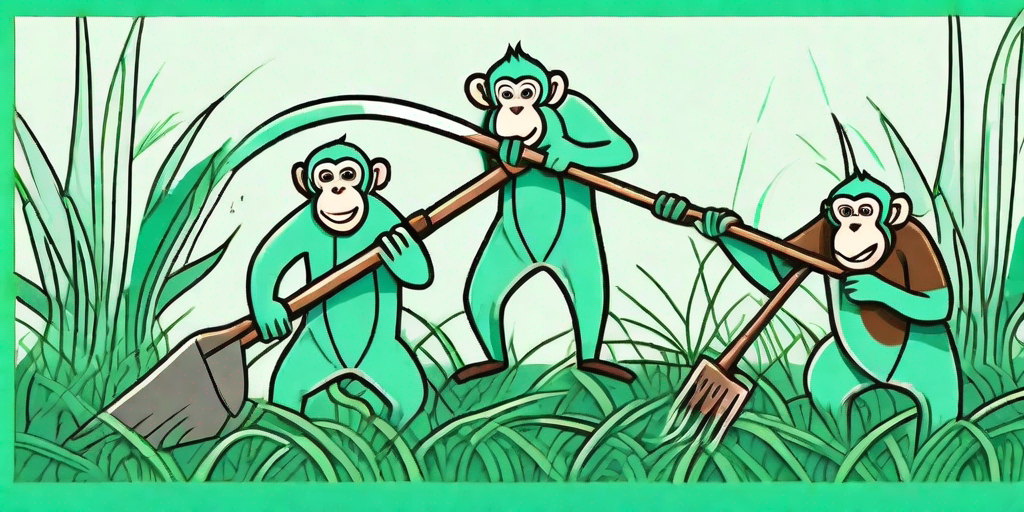
Monkey grass, also known as liriope or lilyturf, is a common sight in many gardens. It's a hardy, evergreen perennial that can quickly take over your lawn if not kept in check. While some homeowners appreciate its lush, green appearance, others see it as a nuisance. If you fall into the latter category, you're in the right place. This guide will arm you with the knowledge and tools you need to reclaim your lawn from this tenacious turf.
Understanding Monkey Grass
What is Monkey Grass?
Before we dive into the eradication methods, it's important to understand what you're dealing with. Monkey grass, scientifically known as Liriope spicata, is a type of ground cover plant native to East Asia. It's known for its grass-like leaves and purple or white flowers that bloom in late summer. While it can be an attractive addition to some landscapes, it's also a vigorous grower that can quickly overrun other plants if not properly managed.
One of the reasons monkey grass is so hard to control is because of its growth habit. It spreads through underground stems called rhizomes, which can quickly form a dense mat of roots. This makes it difficult to remove completely, as even a small piece of root left in the ground can regrow into a new plant.
Why is it a Problem?
Monkey grass may seem harmless, but it can cause several issues in your garden. Firstly, its aggressive growth can crowd out other plants, depriving them of essential nutrients and sunlight. Additionally, its dense root system can make it difficult for water to penetrate the soil, leading to issues with drainage.
Furthermore, monkey grass can be a nuisance to maintain. It requires regular trimming to keep it from spreading, and its tough, wiry leaves can be difficult to cut with a regular lawnmower. This means you may need to resort to more labor-intensive methods, such as hand pruning or using a string trimmer.
How to Eradicate Monkey Grass
Manual Removal
The most straightforward method of eradicating monkey grass is simply to dig it up. This can be a labor-intensive process, but it's also the most effective way to ensure that you've removed all of the plant's roots.
Start by watering the area thoroughly to soften the soil. Then, using a garden fork or spade, dig around the base of the plant, making sure to go deep enough to get under the root system. Once you've loosened the soil, you can pull the plant out, making sure to remove as much of the root system as possible.
Chemical Control
If manual removal sounds like too much work, you can also consider using a herbicide. Glyphosate, the active ingredient in many weed killers, is effective at controlling monkey grass. However, it's non-selective, meaning it will kill any plant it comes into contact with, so use it with caution.
When applying glyphosate, make sure to follow the manufacturer's instructions carefully. It's best to apply it on a calm day to prevent the spray from drifting onto other plants. After application, wait at least a week before planting anything else in the area to ensure the herbicide has fully broken down.
Preventing Monkey Grass from Returning
Regular Maintenance
Once you've eradicated the monkey grass, regular maintenance is key to preventing it from returning. This includes regular mowing and trimming of your lawn, as well as monitoring for any new growth.
It's also a good idea to improve the health of your lawn, as a healthy lawn is less susceptible to weed invasion. This can be achieved through regular watering, fertilizing, and aerating.
Using Landscape Fabric
Another effective method of preventing monkey grass is to use landscape fabric. This is a type of permeable fabric that allows water and air to pass through, but prevents weeds from growing. Simply lay the fabric over the area where the monkey grass was, and cover it with a layer of mulch or gravel.
While landscape fabric can be effective, it's not a permanent solution. Over time, organic matter can build up on top of the fabric, providing a medium for weeds to grow. Therefore, it's important to keep the area clean and free of debris.
FAQs
Is monkey grass harmful to pets?
Monkey grass is not known to be toxic to pets. However, it's always a good idea to monitor your pets and prevent them from eating any plants in your garden, as individual reactions can vary.
Can I compost monkey grass?
Yes, you can compost monkey grass. However, make sure to remove any seeds or rhizomes, as these can regrow in your compost pile. It's also a good idea to chop up the leaves before adding them to your compost, as they can take a long time to break down.
What can I plant instead of monkey grass?
There are many alternatives to monkey grass that can provide ground cover without the invasive tendencies. Some options include creeping thyme, sweet woodruff, and vinca minor.
Conclusion
While monkey grass can be a nuisance, with the right knowledge and tools, you can reclaim your lawn. Whether you choose manual removal, chemical control, or a combination of both, the key is to be persistent and keep an eye out for any new growth. With a bit of effort, you can turn your monkey grass problem into a thing of the past.















